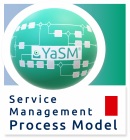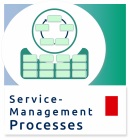Service Transition
Service transition is about ensuring that "any modifications or transitions to the live operational environment meet the agreed expectations of the business, customers and users" [1].
Service transition includes high-level activities such as planning and coordinating service changes, building and testing new or changed service components, and deploying new or changed service components into the live environment.
Service transition in the ITSM frameworks
Service transition has been a prominent topic in service management since the advent of ITIL v3, where service transition is one of the five service lifecycle stages.
The ITIL v3 core publication about service transition describes service transition as the stage that takes the outputs from service design, the preceding stage of the service lifecycle, and uses them to ensure that service solutions smoothly migrated to live operation.
Service transition as described in ITIL v3 includes seven processes:
- Transition planning and support
- Change management
- Service asset and configuration management
- Release and deployment management
- Service validation and testing
- Change evaluation
- Knowledge management.
ITIL® 4 has dropped the service lifecycle concept in favor of a more holistic approach. ITIL v4 does no longer define specific processes that organizations should implement, but most familiar ITIL processes from the service transition book have found their way into ITIL 4 as "practices". Therefore, ITIL v4 refers to 'change management', 'configuration management' and 'service validation & testing' as practices (although change management has been renamed to "change enablement") [2].
Other service management frameworks, such as CMMI-SVC®, USMBOK™ and COBIT®, also include processes for dealing with service transition, although with slightly different names (in CMMI-SVC®, for instance, there's a process area named "SST (Service System Transition)".
VeriSM™ introduces the VeriSM model as "a service management operating model for an organization" [3]. VeriSM describes "high-level stages" for the development and provision of products and services. One of these stages, "produce", resembles the service transition stage in the ITIL service lifecycle and is responsible for building, testing and implementing products or services.
And finally, ISO 20000, the international standard for service management, includes specific requirements for service build and transition.
Service transition process in YaSM
The YaSM service management model translates the guidance from the various ITSM frameworks into a streamlined service transition process. It gets triggered by the service design process once a service definition and a service implementation blueprint have been created. At the end of the service build process, the service that is "ready for activation", which means customers can now be invited to sign a service agreement for the service and start using it.
The service transition process is made up of the following sub-processes:
- Coordinate development and procurement activities
- Develop applications and systems
- Accept delivery of the service components
- Create or update operational documentation
- Test the service components
- Deploy the service components
- Prepare the service activation
For each sub-process, YaSM provides a detailed template that describes the process activities, roles, inputs and outputs.
In addition, the YaSM model contains document templates for the key outputs from the service build process:
- test scripts and test reports, providing a detailed account of testing activities
- the service operation manual, specifying the activities required for the operation of a service and its underlying infrastructure.
All of this is quite straightforward. You can find a complete description of the service transition process in this Service Management Wiki, including definitions of the sub-processes, details about the process outputs, and a RACI matrix.
Change management: A supporting YaSM process
What happened to change management?
There is of course a change management process in the YaSM model, but it is a supporting process outside of service transition. It can be called upon from any other service management processes that need to implement changes, which makes the whole process structure a lot easier to understand.
Related pages
- YaSM service management processes ➔ LP3: Build new or changed services
- ITIL 4 practices and YaSM processes
- YaSM and ITIL V3 ➔ YaSM vs. ITIL service transition
External links and references
[a] IT Process Wiki - ITIL Service Transition. -- S. Kempter: IT Process Wiki, "ITIL Service Transition". - IT Process Maps; Lindau (Bodensee), Germany.
[1] The Cabinet Office: ITIL® Service Transition (2011 Edition). - The Stationery Office; London, UK.
[2] AXELOS: ITIL® Foundation, ITIL 4 Edition. - The Stationery Office; Norwich, UK, 2019.
[3] IFDC (International Foundation for Digital Competences) (2017). VeriSM™ - A Service Management Approach for the Digital Age. Zaltbommel, Netherlands: Van Haren Publishing.
By: Stefan Kempter ![]() , IT Process Maps.
, IT Process Maps.
Service transition in the ITSM frameworks › Service transition process in YaSM › Change management






